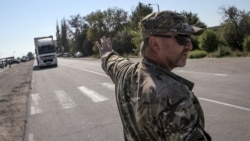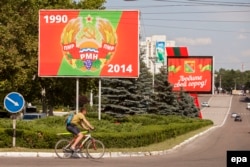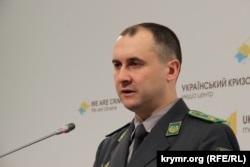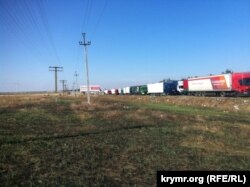Odesa activists are blocking the border with Transdniester, a Russian-backed breakaway region of Moldova.
According to the far-right Azov battalion in Odesa, the blockade is taking place from 12 p.m. until 2 p.m. today. The activists will only block cars with Transdniester license plates.
“This event is aimed, primarily, to pressure the Kremlin...powerS in Transdniester, who constantly lie in their propaganda about an alleged Ukrainian economic blockade of Transdniester,” reads an Azov statement.
According to the organizers of the event, Moldovans who were forced to leave the separatist region due to “political persecutions,” will block the border from the other side.
The Odesa wing of Right Sector will also take part in the blockade. According to its spokesperson, Varvara Chernoyvanenko, the blockade will also be held in solidarity with the Crimean Tatars’ blockade of Crimea.
This is getting a lot of play on Twitter today. The feelings of the new leader of the U.K. Labour Party on Ukraine-Russia-NATO:
BREAKING from Reuters: GERMAN FOREIGN MINISTRY SPOKESWOMAN SAYS RUSSIA SHOULD EXERCISE INFLUENCE ON SEPARATISTS IN EAST UKRAINE TO PREVENT HOLDING OF LOCAL ELECTIONS
No trucks have passed through the administrative border from mainland Ukraine to Crimea overnight, said Oleh Slobodyan, the spokesperson for Ukraine’s State Border Service.
Some trucks have been returning back to Ukraine, he said, according to RFE/RL's Crimean desk .
As of 11 a.m., there are about 80 trucks at the Kalanchak checkpoint, 110 at Chaplynka, and no trucks at Chonhar.
A day before, around 150 trucks were at Kalanchak, and around the same number -- at Chaplynka.
At the same time, Slobodyan said that cars cross the border easily, along with trucks that are returning to Ukraine, provided they have all the necessary documents.
Kherson Vesti has produced a drone video of the Crimean blockade. The video, shot at the Chongar checkpoint, shows people holding Ukrainian and Crimean Tatar flags while preventing cars from passing.
The situation on the administrative border of Crimea in Kherson Oblast remains calm as of this morning, RFE/RL's Crimean desk reporters say. All three checkpoints that lead from mainland Ukraine into Crimea are under a blockade.
About 300 people are currently at the Chonhar checkpoint. Among them are Mejlis representatives, civic activists, military personnel, and journalists. Chairman of the Mejlis Refat Chubarov has also arrived at the checkpoint.
About 90 trucks remain at the Kalanchak checkpoint on the territory of Ukraine, and about 20 others are in the neutral zone. Around two dozen activists are at that checkpoint. This morning two cars with OSCE markings arrived there.
At the Chaplynka checkpoint there are around 80 trucks, according to the Crimean desk.
The Crimea blockade appears to be working. From Interfax.
KYIV. Sept 21 (Interfax) -- The blocking of truck traffic to and from Crimea across the border with the Kherson region continues.
"Trucks are being turned back in part and are leaving their [current] locations in Kalanchak and Chaplynka. We have secured our positions in Changar: mobile roadblocks have been delivered there and defense lines have been created," deputy head of the Kherson regional police department Ilya Kyva told the television channel 122 on the phone on Monday morning.
He said that not a single truck crossed 'the administrative border' last night.
A number of Ukrainian politicians had declared their intention to start blocking the delivery of Ukrainian commodities to Crimea on September 20 to protest against the peninsula's reunification with Russia. The authorities of the Russian region replied that Crimea was receiving most commodities from Russian producers, and that the siege would primarily do harm to the enterprises of southern Ukraine oriented towards the Crimean market.
Reuters curtain-raiser for NATO chief Jens Stoltenberg's visit to Kyiv today:
With a troubled peace plan for the Ukrainian conflict nearing its deadline, NATO chief Jens Stoltenberg will attempt a balancing act to reassure Kiev of the West's support without antagonising Moscow when he visits Ukraine on Monday.
Ukrainian diplomats say Stoltenberg's visit, his first there, is symbolic in their quest for Western integration as Russia backs a rebellion in eastern Ukraine 18 months after it seized Crimea.
They plan to sign a new doctrine in Stoltenberg's presence identifying Russia as an aggressor.
"This visit will be a milestone," said Ukraine's acting ambassador to NATO, Yehor Bozhok. "In Soviet times, we were ready for an attack from the West. Reality now demonstrates that the threat comes from the East," he told Reuters.
But Stoltenberg, a former Norwegian premier who a year into the top NATO job has toned down the strident criticism of Russia by his predecessor, is wary of raising tensions. He is highly unlikely to heed Kiev's calls for defensive weaponry supplies.
Stoltenberg sees Ukraine as the most complex of Europe's many crises and backs the 11-step Minsk peace deal signed in February that set an end-year deadline for implementation.
Stoltenberg also sees the alliance's role as mainly limited to helping rebuild the armed forces of Ukraine, which is not a NATO member, after years of mismanagement.
Ukraine dropped its bid to join the organisation in 2010 to please Moscow, but now says NATO membership as the only way to protect its territory. NATO wants to avoid provoking Moscow.
Russia opposes any potential expansion of NATO to former communist areas of eastern and southeastern Europe, part of a battle for influence between Brussels and Moscow that lies at the heart of the conflict in Ukraine.
"I am really afraid that the situation can deteriorate," Stoltenberg said in July of the conflict in eastern Ukraine that has killed some 8,000 people. "That's something we have to try to avoid because the situation is demanding enough as it is."
RUSSIAN 'ATTACK'
While violence is at its lowest ebb since the Minsk ceasefire was signed seven months ago, Ukrainian President Petro Poroshenko has warned that the decision by separatist rebels to hold their own elections could invalidate the whole peace plan.
Poroshenko is also under pressure from Europe to reform faster to receive potentially billions of euros in donor funds.
"The list of things Ukraine needs to do is endless. You can always do more. But on the other side (Russia), the list hasn't even begun to be filled in," said a senior EU diplomat whose government is among those most critical of Russia's actions.
In another sign of his balancing act during his two-day visit, Stoltenberg will inaugurate exercises between Ukraine and NATO, but they are not military, rather civil protection.
In the pro-European west of the country, they will focus on de-mining, forest fires and a simulated blast at a factory.
Still, Stoltenberg will be the first NATO secretary general to sit in on a National Security and Defence Council meeting in Kiev, Ukraine says, and will likely witness Poroshenko sign the new military doctrine into law.
The octrine "defines the Russian Federation as a military adversary" and "assumes the high probability of large-scale use of military force against Ukraine," a statement says.
Stoltenberg will also oversee the opening of a bigger NATO liaison office in Kiev with full diplomatic status.
Yet even that gesture brings complications. The office has been described by Ukrainian Foreign Minister Pavlo Klimkin as a new "NATO embassy", underscoring the country's long-term aspiration of joining the U.S.-led alliance.
Many Russians defend Russian President Vladimir Putin's annexation of Crimea, saying it was needed to stop U.S. ships moving in there if Ukraine becomes a NATO member.
For our Ukrainian-language readers. Top stories from our services over the weekend.
NATO Secretary-General Visits Ukraine
Crimean Tatars and Ukrainian Activists Block Roads Leading to Annexed Crimean Peninsula
Tatars Will Continue Crimean Blockade, Crimean Tatar Leader Says
Saakashvili's Right-Hand Man, Sacha Borovyk, Tells RFE/RL About Reforms in Odessa Region
Slow news day so far...







